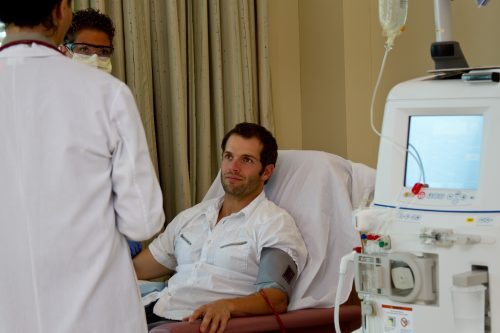
Boston—Timely communication between patients on peritoneal dialysis and providers can be enhanced using remote patient monitoring. Previous studies found an association between peritoneal dialysis modality longevity and remote patient monitoring compared with standard communications (no remote patient monitoring).
Harold Giles, MD, and colleagues recently performed bootstrap resampling analysis to address potential confounding by start year of peritoneal dialysis. The current analysis also compared markers of adherence to therapy between remote patient monitoring and standard communications. Results of the analysis were reported during a poster session at the NKF Spring Clinical Meetings in a poster titled Remote Patient Monitoring (RPM) and Longevity on Peritoneal Dialysis (PD): An Analysis Controlling for Confounding by PD Start Year.
Data on peritoneal patients using the Liberty Cycler for >30 days from 2012 to 2017 were extracted. Remote monitoring patients were required to transmit data through a modem within 30 days of initiation of peritoneal dialysis. The researchers controlled for peritoneal start year via a 1:1 match of standard communications patients (n=12,032) and remote monitoring patients (n=714). Bootstrapping was used to create 1000 randomly selected standard communications cohorts; hazard ratios were averaged. Availability of baseline peritoneal dialysis Kt/V was used as a proxy for therapy adherence.
Patients continued peritoneal dialysis modality for an average of 625 days for remote monitoring patients and 581 days for patients in the standard communications group (difference, 44 days). Compared with standard communications, the rate of stopping peritoneal dialysis was 11% lower with remote patient monitoring (hazard ratio [HR], 0.89; 95% confidence interval [CI], 0.81-0.97). Mortality rate was lower in remote monitoring patients (HR, 0.76; 95% CI, 0.67-0.87) and there was a trend toward 19% higher transplantation rate in remote monitoring patients compared with standard communications (HR, 1.19; 95% CI, 0.98-1.47). There was no difference in rate of transfer to hemodialysis (defined as transfer to hemodialysis with no return to peritoneal dialysis in 6 weeks).
Baseline peritoneal dialysis Kt/V data were available for most patients: 97.8% for the remote patient monitoring group and 97.1% for the standard communications group. Prior analysis (without match) found a larger difference in days on peritoneal dialysis (106 vs 44 days), The magnitude of effect comparing remote patient monitoring to standard communications lessened slightly for HR of stopping peritoneal dialysis (prior HR, 0.85 vs current HR, 0.89), HR of death (prior HR, 0.74 vs current HR, 0l76), and HR of transplantation (prior HR, 1.27 vs current HR, 1.19).
In conclusion, the researchers said, “The association between remote patient monitoring of peritoneal patients and longevity on peritoneal modality was confirmed in this analysis with matched bootstrap sampling to control for peritoneal start year.”
Source: Giles H, Li Y, Mullon C, et al. Remote patient monitoring (RPM) and longevity on peritoneal dialysis (PD): An analysis controlling for confounding by PD start year. Abstract of a poster presented at the National Kidney Foundation 2019 Spring Clinical Meetings, May 8-12, 2019, Boston, Massachusetts.







 © 2025 Mashup Media, LLC, a Formedics Property. All Rights Reserved.
© 2025 Mashup Media, LLC, a Formedics Property. All Rights Reserved.